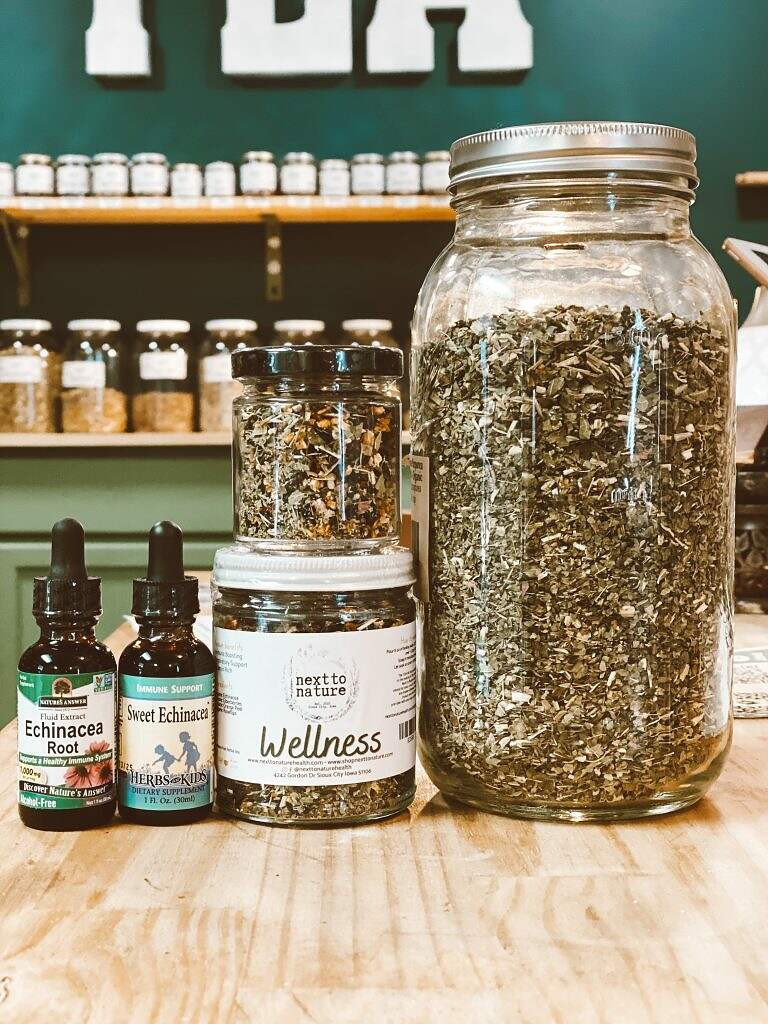Echinacea is the name of a group of flowering plants in the daisy family. They’re native to North America where they grow in prairies and open, wooded areas. The leaves and flower can be harvested in summer when flowers are in full bloom. Roots are generally best in the fall after the first frost. Echinacea is an at-risk plant in the wild, so be sure to purchase organically cultivated or grow your own.

Altogether, this group has nine species, but only three are used in herbal supplements — Echinacea purpurea, Echinacea angustifolia and Echinacea pallida. Both the plant’s upper parts and roots are used in tablets, tinctures, extracts, and teas.
What Echinacea is used for:
Echinacea angustifolia is an immune stimulant and modulator traditionally used by North American plains people for at least 400 years for symptoms in the throat and mucus membranes, topically for snake and insect bites as well as burns and skin afflictions (using a mashed paste of the entire plant), dental cavities, venereal disease, gastrointestinal (GI) tract disorders, and even arthritis. The plant was called “elk root” after plains people observed wounded and sick elk eating the plant . Native Americans probably did not use this plant to prevent colds but some First Nations people used it to treat certain symptoms of the common cold.
The part of the plant most commonly used was the root and flower head, as an antimicrobial, analgesic, and anti-inflammatory. The Eclectic physicians helped introduce Echinacea as an antimicrobial herb to the European and European-American medical professionals, and by the late 1800s it was the most commonly used herb in the U.S.
How to use Echinacea:
The above ground parts of the plant and roots of echinacea are used fresh or dried to make teas, expressed juice, extracts and tinctures, or preparations for external use. These plants contain an impressive variety of active compounds, such as caffeic acid, alkamides, phenolic acids, rosmarinic acid, polyacetylenes and many more. In addition, studies have linked these plants and their compounds to many health benefits, such as reduced inflammation, improved immunity and lower blood sugar levels.
Here’s a few to steeping Echinacea as a tea: 7 Simple Steps to Brewing Our Tea
Let’s discuss more health benefits of this plant.
High in antioxidants
Echinacea plants are loaded with plant compounds that function as antioxidants. Antioxidants are molecules that help defend your cells against oxidative stress, a state that has been linked to chronic diseases, such as diabetes, heart disease and many others. Some of these antioxidants are flavonoids, cichoric acid and rosmarinic acid. These antioxidants appear to be higher in extracts from the fruit and flowers of the plants, compared to other parts, such as the leaves and root. In addition, these plants contain compounds called alkamides, which can further enhance antioxidant activity. Alkamides can renew worn-out antioxidants and help antioxidants better reach molecules that are prone to oxidative stress.
Immune system support
Research on echinacea suggests that it offers several impressive health benefits. Echinacea is best known for its beneficial effects on the immune system. Numerous studies have found that this plant may help your immune system combat infections and viruses, which could help you recover faster from illness. That’s one reason why echinacea is often used to prevent or treat the common cold. In fact, a review of 14 studies found that taking echinacea may lower the risk of developing colds by more than 50% and shorten the duration of colds by one and a half days.
May lower blood sugar levels
High blood sugar can raise your risk of serious health problems. This includes type 2 diabetes, heart disease and several other chronic conditions. Test-tube studies have found that these plants may help lower blood sugar levels. In a test-tube study, an Echinacea purpurea extract was shown to suppress enzymes that digest carbohydrates. This would reduce the amount of sugar entering your blood if consumed. Other test-tube studies found that echinacea extracts made cells more sensitive to insulin’s effects by activating the PPAR-y receptor, a common target of diabetes drugs. This particular receptor works by removing excess fat in the blood, which is a risk factor for insulin resistance. This makes it easier for cells to respond to insulin and sugar.
May reduce feelings of anxiety
Anxiety is a common problem that affects close to one in five American adults. In recent years, echinacea plants have emerged as a potential aid for anxiety. Research has discovered that these plants contain compounds that may reduce feelings of anxiety. These include alkamides, rosmarinic acid, and caffeic acid. Much research is needed for these properties in this plant, but the compounds within are linked to reduced anxiousness.
Anti-inflammatory properties
Inflammation is your body’s natural way of promoting healing and defending itself. Sometimes inflammation can get out of hand and last for longer than necessary and expected. This may raise your risk of chronic diseases and other health problems. Several studies have shown that echinacea can help reduce excess inflammation. In a mouse study, echinacea compounds helped reduce important inflammatory markers and memory-loss caused by inflammation. In another 30-day study, adults with osteoarthritis found that taking a supplement containing echinacea extract significantly reduced inflammation, chronic pain and swelling. Interestingly, these adults did not respond well to conventional non-steroidal inflammatory drugs (NSAIDS) but found the supplement containing echinacea extract helpful.
Conclusion
Echinacea has traditionally been used to treat or prevent colds, flu, and other infections. It is believed to stimulate the immune system to help fight infections. Less commonly, this plant has been used for wounds and skin problems, such as acne or boils. This beautiful plant brings healing properties and is part of our Wellness herbal tea blend. We have it as the loose herb and tincture to easily work into your health routine. Last fun fact: Echinacea angustifolia produces a curious tingling sensation on tongue, which can be a bit alarming the first time one experiences it. If your Echinacea root tincture does not produce this signature sensation, it probably isn’t very potent. The tingling is not an allergic reaction but is your tissues reacting to the active compounds in your Echinacea remedy. It’s a good sign!

Source: https://www.healthline.com/nutrition/echinacea, https://www.bumc.bu.edu/integrativemed/files/2010/01/Echinacea.pdf
Stay connected with nature! Join us on the journey to healthy living.
Instagram: https://www.instagram.com/nexttonaturehealth/
Facebook: https://www.facebook.com/nexttonaturehealth
Online Shop: https://www.shopnexttonature.com/
Sources:
(Buhner, 2012)
(Goldhaber-Fieber, 1999)
(Tilford, 1997)
(Moerman, 1998)
(Goldhaber-Fieber, 1999)
